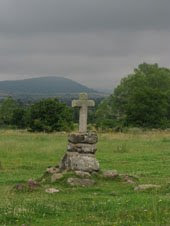

There are ancient Celtic carvings in grey stone in the Basque country; while on the road to Espalion by the Lot river, a romanesque cross in pink granite shows Saint Hilarian carrying his head home to his mother after it was chopped off by the Saracens.
Many are the tall iron crosses with intricate garlands, hearts or cherubs that are the work of some local blacksmith. I remember suffering Christs in eerie flesh tones against the steel skies of Picardy. And the red-painted four-by-four posts nailed together under a tree at the turning for Vézeley. Was it the glowing red paint or the yellow rape in the field behind that made this simple cross such a landmark?
In spring we read the “Song of Roland”, the early Medieval poem of the legend of Charlemagne and his nephew Roland, who beat the Moors at the Roncevaux pass from France into Spain. Roland died valiantly in the battle and on the rock where his body fell a cross was erected, still known as the Cross of Roland. It is a montjoie, named after Charlemagne’s battle cry and a word still used for so many of the crosses of the St Jacques’ route – cries of triumph and thanks in high places.
I don’t know if the people of the Auvergne are naturally more pious than their compatriots or whether in the splendidly austere Aubrac plateau with its summer cattle drives and frozen winters, the need for guidance and reassurance is that much greater. A fifteen-mile walk here is punctuated by fifteen or more crosses. Before 1182, when a Benedictine hospice was built at Nasbinals, pilgrims had to traverse all 120 kilometres of the Aubrac plateau without shelter. The sight of a cross against the horizon must have been especially 
10th August 2008
Wednesday, 13 August 2008
A cross marks the spot
Posted by
Rachel Escott
at
17:44
![]()







































































No comments:
Post a Comment